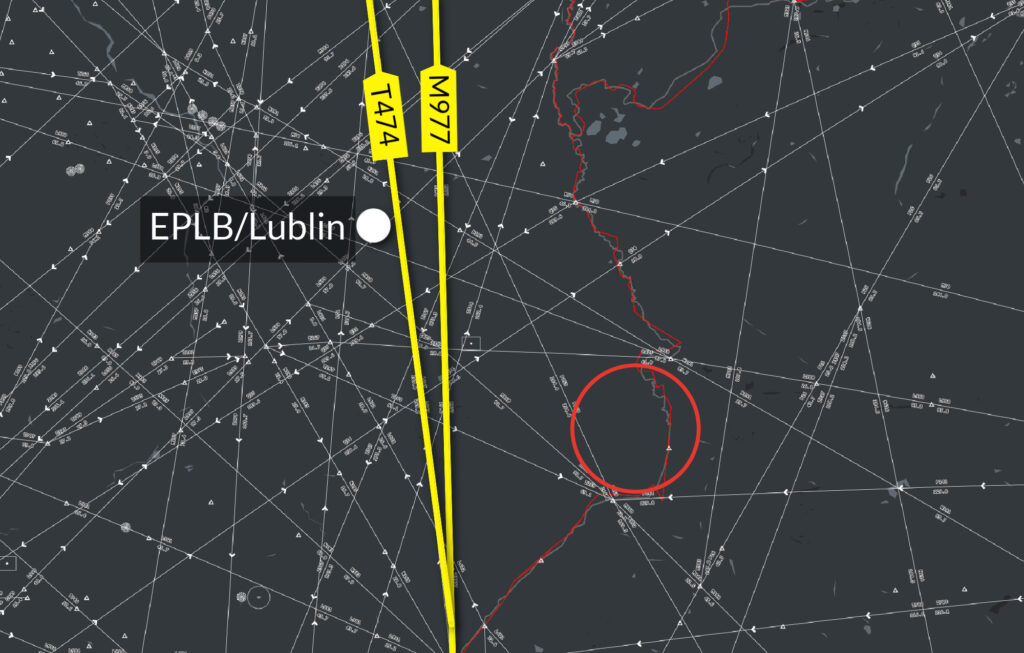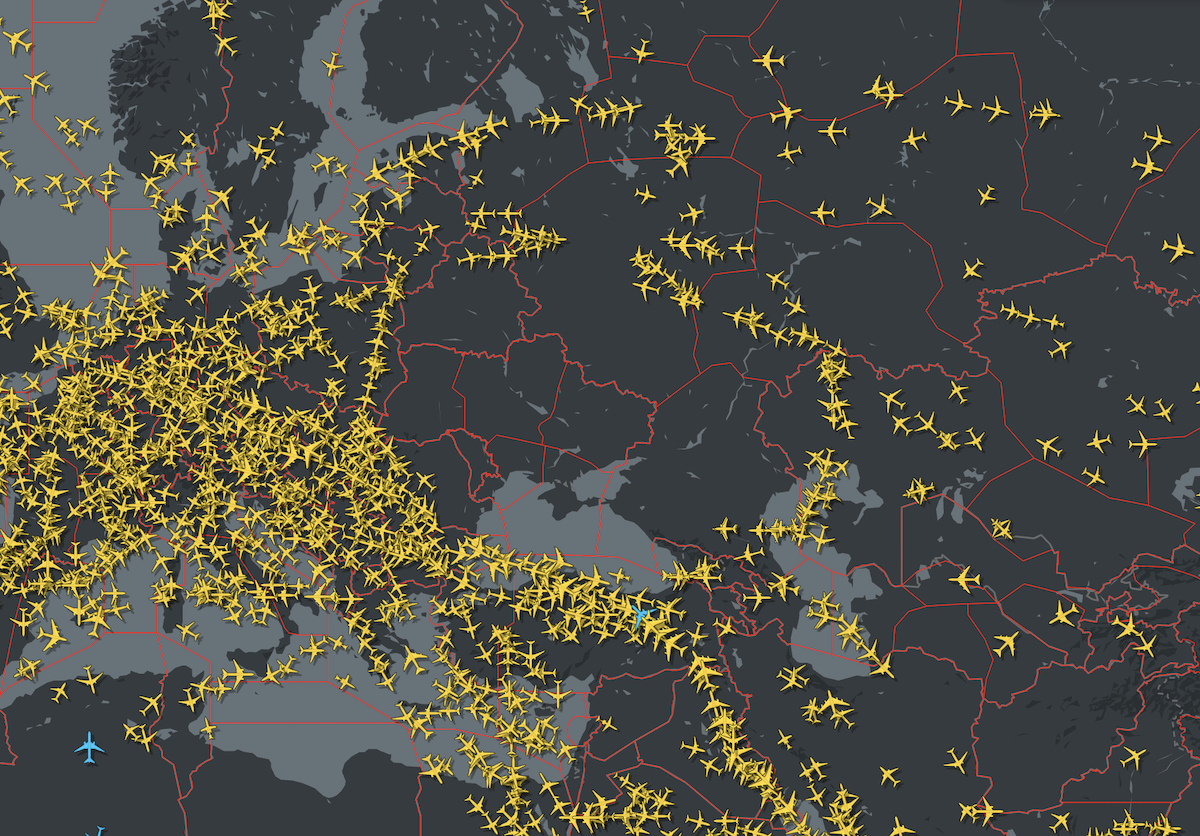A missile involved in the Russia-Ukraine conflict fell in Poland on Nov 15, close to the border with Ukraine. There are no prohibitions or warnings for Polish airspace, however the border region is (clearly) high risk and operators should avoid flights in or over this area.

Ukraine and Poland.
The following map shows two airways which lie in proximity to the border and which may be used by overflying aircraft. The airways routing into Ukraine, Belarus or utilised for routes into prohibited airspaces have not been highlighted.

Airways in proximity to border.
The ongoing conflict between Russia and Ukraine continues to pose challenges and risks to international flight operations.
We covered these previously in this post which looked at:
- Ukraine, Moldova, Russia and Belarus airspace closures.
- Which countries have banned Russian aircraft and operators, and which countries has Russia banned in response?
- The differences between the sanctions imposed on Russia by the US, the UK, and the EU, and the nuances of how these sanctions may impact your flight.
- Considerations for operators now looking to route around Russian airspace.
- Information on Humanitarian relief missions.
What has changed?
In terms of the above, very little. Ukrainian airspace remains closed and poses a significant risk to aircraft.
All the major countries who regularly issue airspace warnings (the US, UK, Canada, France, Germany, plus several more) have issued total flight bans for Ukraine due to risk from military activity at all levels.
The primary risk is an unintended targeting of civil aircraft by military, including misidentification (as with MAS17, UIA752).
What has changed is the potential spillover risk. The FAA has released an Information Note regarding this, which you can read here.

Maps the current SFARs and their area of applicability.
What does it say?
Pretty much an updated report of what we said in this post back in March 2022.
In a nutshell – “Russia’s increased use of developmental weapons, use of weapons in nontraditional roles, and long-range missile strikes into western Ukraine increases potential spillover risk concerns for U.S. civil aviation operations in adjacent airspace.”
In other words, the risks and hazards are not necessarily confined to the geographical borders which are used to define ‘risky airspace’ (the areas covered by current conflict-related flight prohibition NOTAMs and other warnings).
The three main points in the FAA Information Note are these:
- Russia periodically launches missiles targeting Ukraine which transit Moldovan airspace.
- There have been reports of comms and GPS jamming outside the conflict zone, particularly over the Black Sea and Caspian Sea.
- Drone/UAS activity has expanded, especially around Crimea and eastern Ukraine.
1. Missile launches
Russia periodically launches missiles targeting Ukraine from positions in the Black Sea and Caspian Sea. The flight paths for these generally route across Moldovan airspace.
Moldova initially closed all their airspace, but have since opened a section on their western border with the LRBB/Bucharesti FIR for flights to LUKK/Chisinau airport.
On Nov 15, a missile fell in Poland, close to the border with western Ukraine. It is not clear whether this was launched by Russia or by Ukrainian Air Defenses, but it signifies a heightened level of risk in regions bordering the conflict zone which are not necessarily covered in prohibitions and warnings.
An awareness of the proximity to significantly high risk airspace is advised.
The FAA SFAR related to the conflict and listing the prohibited airspaces can be read here.
2. GPS Jamming
This has been reported beyond the regions outlined in NOTAMs and airspace warning areas.
Civil aircraft flights who route close to the borders of the conflict zone, or which transit the southern Black Sea or northern Caspian Sea may experience jamming.
A member reported – “Flew recently from the UAE over Iraq and Turkey and over the western edge of the Black Sea. Once inside Turkey, the GPS signal was lost and remained out until northwest of the of western Black Sea. Dual GPS plus a portable GPS receiver confirmed the loss of signal. Also, no satellite wifi during same period.”
EASA has issued Safety Information Bulletin on Global Navigation Satellite System (GNSS) jamming in the Baltic Sea area which you can find here.

Routes near the conflict zone may experience Jamming and other hazards.
3. Drone/UAS hazard
The use of Unmanned Aircraft Systems (UAS) has been increasing, on the Russia side.
These fly at lower altitudes (they say a max of about 16,000′) and there is a risk of ‘errant activity’ ie not flying where they should fly. In June 2022, one such errant UAS was reported in eastern Turkey.
These represent a hazard to aircraft given their size, the fact they are generally weaponised, and the fact they are not always where they are supposed to be.
Other spillover risks
These are not covered in the FAA note, but we figured worth mentioning anyway:
- Increased traffic levels: Turkey is seeing higher traffic levels due airspace closures, as aircraft now transit their airspace. There is also an increase in military traffic in airspace bordering the conflict zones.
- Crew fatigue: Longer routes, more challenges en-route, operational and planning challenges have not gone away, we are just staring to see them as the ‘status quo’.
- Ongoing fuel and energy supply issues: These are more indirect, but the increase in costs and availability has led to some supply issues, as well as protests across many regions which means potential disruptions and security concerns.
Stay updated!
A full briefing on the airspace risks with up to date notice and NOTAM references can be found at Safeairspace.net
Please report back to us any new info you come across (be it airspace risk related, or simply sharing your experience of a recent flight) and we can help redistribute that info back out to the group so that all are aware.
You can email us at news@ops.group, or file a report of a recent trip on our Airport Spy page here: ops.group/blog/spyreport
More on the topic:
- More: Airspace Risk Update – Important Changes You May Have Missed
- More: Get ready for more North Korean missiles
- More: Airspace Risk: Conflict Zones and Security in 2023
- More: North Korea Missile Threat
- More: Is the Fuel Pool Drying Up?
More reading:
- Latest: OPSGROUP is hiring! Wanted: Junior International Ops Specialist
- Latest: LOA Guide for US Operators
- Latest: NAT Ops: Flying the Blue Spruce Routes
- Safe Airspace: Risk Database
- Weekly Ops Bulletin: Subscribe
- Membership plans: Why join OPSGROUP?












 Get the famous weekly
Get the famous weekly 





